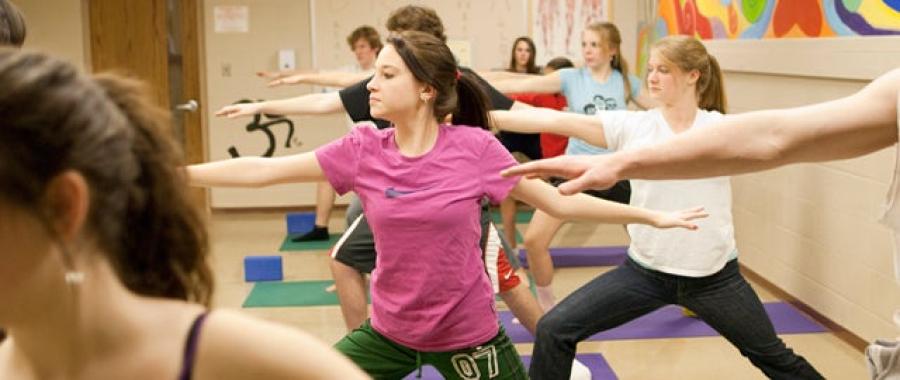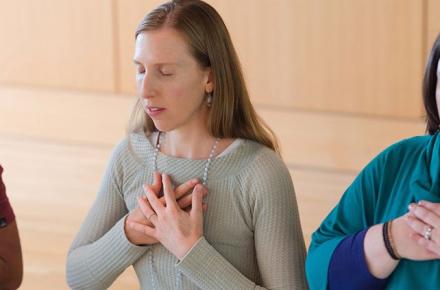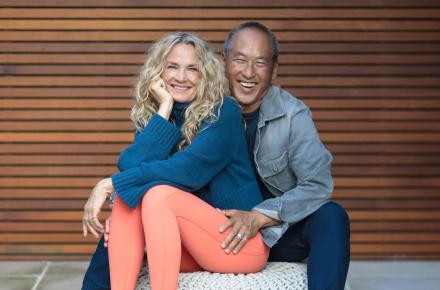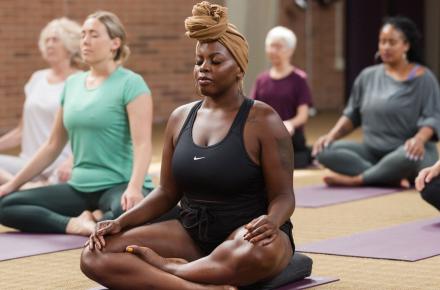Yoga Goes to High School

by Olga Overmyer
I’m waiting in the yoga classroom of a western Massachusetts high school—the site of one of the Kripalu Yoga in the Schools projects being developed and scientifically evaluated by the Kripalu Institute for Extraordinary Living. The room is decorated in vibrant student-painted murals and yoga posters, transforming the windowless space, which was once the detention room, into a bright area for mindful movement and self-inquiry. The bell rings and instead of desks and chairs, students filter into a circular arrangement of yoga mats. With upbeat melodies humming in the background, bags and shoes are left at the door. One student, who three weeks earlier came to class with snacks and a cell phone in hand, greets me today with a smile and goes sit on his mat, looking receptive. I assist the instructor by inviting the rest of the group to find a comfortable seat. We’re ready to begin.
It’s no revelation that adolescents today are stressed. Naturally, in a time of physical and psychosocial transformation, teens face the tasks of identity development and belonging—while managing a cascade of hormonal changes. For many, the teenage years can feel like a minefield, finding the precarious balance between standing out and fitting in, trying on values and dealing with the accompanying emotions. The demands of academic and extracurricular achievement, along with decisions about whether and how to get to college, weigh as well. It’s a heavy toll! And that’s assuming there’s stability at home. Knowing that lifelong patterns take root in adolescence, yogic wisdom offers support. Tools to manage life’s challenges and practice self-compassion are at the heart of what’s available.
Yoga practitioners ourselves, we’re steeped in anecdotal evidence of the life-enhancing effects of sustained practice. But scientific inquiry provides us with additional insight into the condition of the adolescents we’re teaching. Institute collaborators Sat Bir S. Khalsa, principal investigator and prominent yoga researcher, and Postdoctoral Fellow Jessica Noggle, report that students participating in the yoga program maintain equilibrium on a variety of psychological markers over the course of a semester. While students in the control group experience deteriorated well-being over time, their yoga-practicing counterparts remain steady. In other words, even a couple of hours of yoga a week can facilitate resilience during the tumult of adolescence.
Beyond asana practice, this program introduces students to a more conscious and empowered way of life. Conversations with participants, teachers, and school administrators present a broad scope of real-life impacts. “The yoga class relaxed me,” says one student. “It made me aware of how stressed out I get and taught me new ways to deal.” Repeatedly, students report using techniques they’ve learned, especially deep breathing, to reduce anxiety at school, cool temper during conflicts, and fall asleep at night. The school principal affirms: “As they’re taking the yoga classes, the kids’ grades have gone up… they’re able to internalize yoga and apply these skills to improve sleep, lessen anxiety, and work better with their peers, parents, and teachers.” A couple of students have even described a more positive attitude toward challenging peers after a class in which they were guided through loving-kindness meditation.
As was true in my own experience of finding yoga at 16—when I knew immediately that yoga was doing something for me but had no clue of how it would ultimately flourish in my life—this feels like a beginning. This beginning culminates in the optimal application and scientific understanding of yoga for teens and a beginning of each participant’s yoga journey. By introducing students to the view and skill set available in yoga at one of the most challenging stages in life, I believe we open a passageway for lifelong self-exploration and healthy habits. Where will the road lead for the students, schools, and society? We hope this research will mature into a longitudinal study to find these answers. In the meantime, participant stories, colorful yoga murals, and the transformations I’ve observed in the span of a 45-minute class are inspiring and make me excited for the long-term possibilities.
Olga Overmyer is a Kripalu Yoga teacher and life coach who holds a master’s degree in East-West psychology from the California Institute of Integral Studies.
© Kripalu Center for Yoga & Health. All rights reserved. To request permission to reprint, please e-mail editor@kripalu.org.


















































